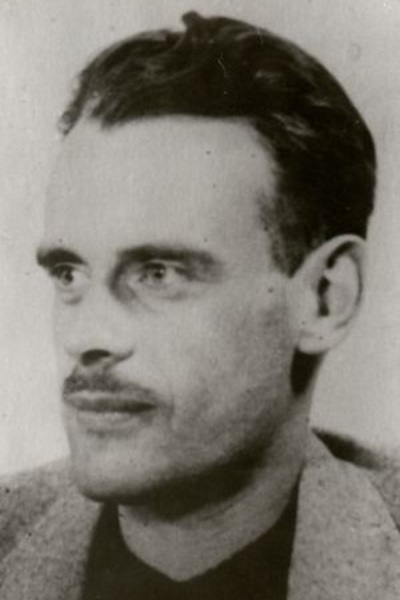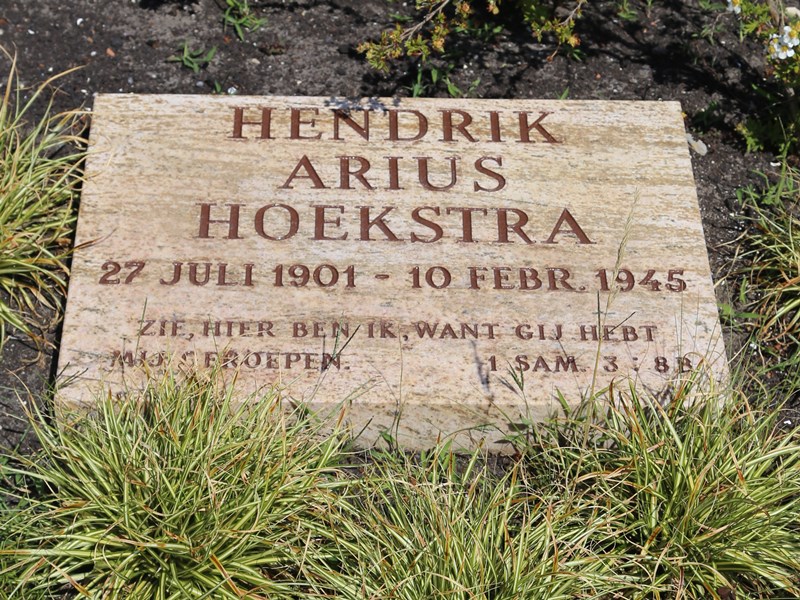Hoekstra, Hendrik Arius
- Date of birth:
- July 27th, 1901 (Harlingen/Friesland, Netherlands)
- Date of death:
- February 10th, 1945 (Blaricum/North Holland, Netherlands)
- Buried on:
- Dutch Honorary Cemetery Bloemendaal
Plot: 35. - Nationality:
- Dutch
Biography
Lived outside the built-up area of Blaricum, Woensbergweg 2. Son of timber merchant Jan Freerk Hoekstra (2 October 1872 Harlingen – 6 March 1959 Haarlem) and Alida Leenmans (17 December 1872 Wilnis). Married to Catharina – Tinie – Koopmans (13 May 1912 – June 1997). The couple had three children: Alida, Jan and Danielle. Mechanical engineer/designer of aircraft and laboratory instruments. No church.
Shortly after the German invasion, Henk Hoekstra made an unsuccessful attempt to flee to England. Together with his brother-in-law Remmert Aten, he built a boat, but they were unable to get it to the coast. He soon became part of the resistance. The Hoekstra-Koopmans couple gave shelter to people in hiding, including the Canadian aviator (‘flying officer’) Edward J.C. Kryskow. In 1941, Hoekstra came into contact with the Dutch weekly Vrij Nederland. Hendrik Hos (1*) asked the Blaricum resident to build transmitting and receiving equipment, because he considered it important to (also) establish direct contact with London. After his arrest on 1 December 1942, contact with Vrij Nederland weakened. The transmitters that had been built ended up in the hands of the Ordedienst (Order Service). Hoekstra played an important role in the OD's Radio Service, led by Jan Thijssen, by building and maintaining transmitting equipment and expanding transmission networks. He himself became commander of a transmission network in the Gooi region. In September 1944, Station-I was established in his home. Many hundreds of messages and messages were sent and received by radio operators there. On 10 February 1945, however, his house was raided. When an Sipo officer tried to handcuff him, he tried to grab his gun, but it got stuck in his clothing. He was then shot dead. His wife, who attacked the Sipo employees, was overpowered and taken to the detention centre on Amstelveenseweg in Amsterdam. She was imprisoned until 1 April 1945.
Hoekstra was posthumously awarded the Bronze Lion by Royal Decree no. 24 dated 14 December 1949.
He was also awarded the American Medal of Freedom with bronze palm and the British Tedder award. His wife Brouwer-Koopmans, who had remarried after having worked as a courier and helped decode messages, was also honoured. By Royal Decree no. 13 dated 11 September 1952, she received the Cross of Merit. The motivation for this award includes the following: ‘She was his right-hand woman in these tense months and hid in her house the three radio operators who kept the service running day and night and who were not discovered during the raid (3*). Even after her arrest she remained silent and saved the lives of many others. In October 1948 she was awarded the British honour King's Medal for Courage in the Cause of Freedom.
(1*) Hendrik Pieter Hos (1 December 1906 Haarlem – executed 11 May 1944 Waalsdorpervlakte).
(2*) Jan Thijssen (29 December 1908 Bussum – executed 8 March 1945 Woeste Hoeve). After a violent conflict, Thijssen was dismissed by the chief of staff of the Ordedienst, esquire Pieter Jacob Six (5 April 1894 Amsterdam – 27 April 1986 ‘s Graveland). Thijssen quickly set up a new radio service for the Council of Resistance, which he had co-founded.
(3*) The radio operators Jan Maarten Pigeaud and Henk Nieuwkamp were present in the house at the time of the raid. They managed to disappear in time with their transmitting and receiving equipment in the hiding place under the living room floor. When there was no longer any Sipo in the house, Hoekstra's daughter Alida, who had just turned eight, and a neighbour removed the two radio operators from their hiding place.
Buried in the dune region near Overveen, grave pit R. Later reburied at the Bloemendaal Cemetery of Honour.
Do you have more information about this person? Inform us!
Sources
- Photo 1: Eerebegraafplaats Bloemendaal
- Photo 2: Jeroen Koppes
- Peter H. Heere en Arnold Th. Vernooij, De Eerebegraafplaats te Bloemendaal, SDU Uitgevers, Den Haag, 2005; Hendrik Arius Hoekstra; Oorlogsgravenstichting; site wiewaswie.nl (waaronder overlijdensakte 14/1945 gemeente Blaricum)




